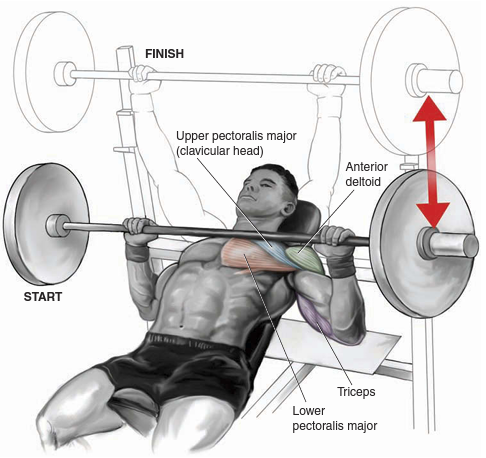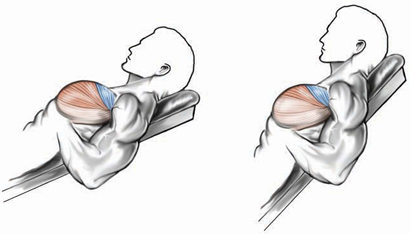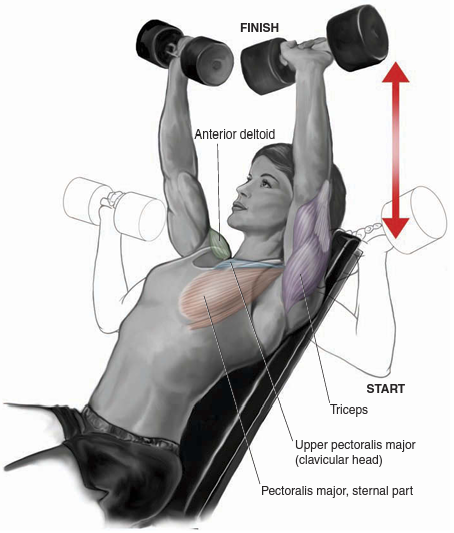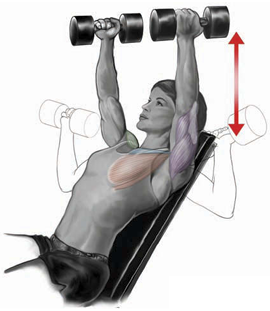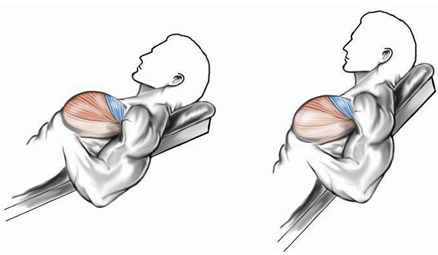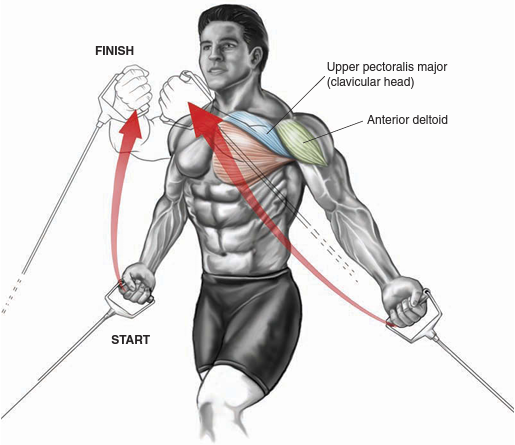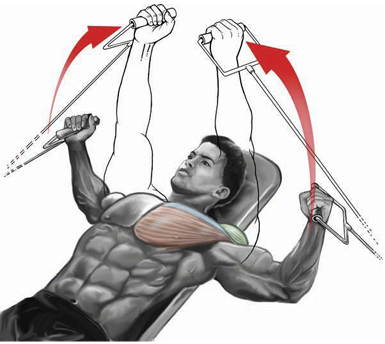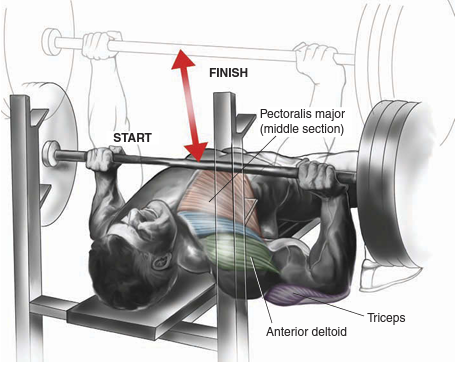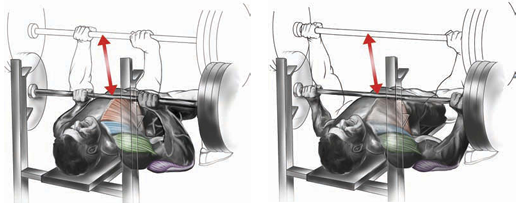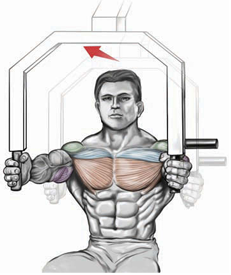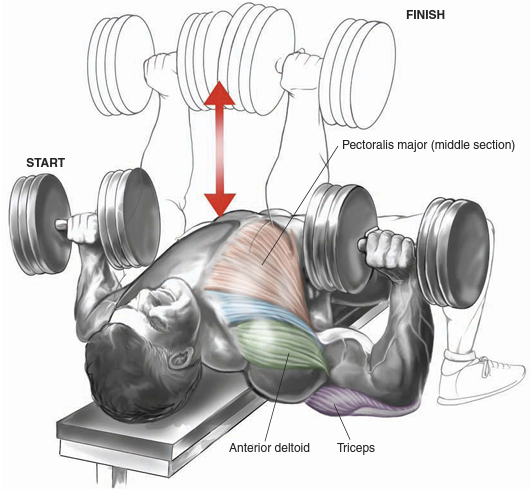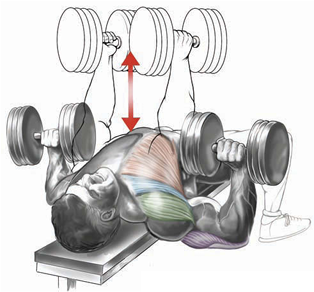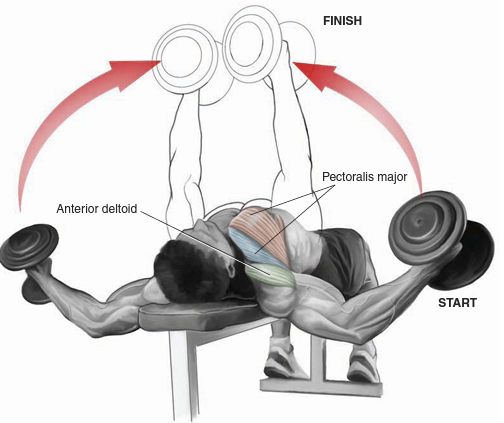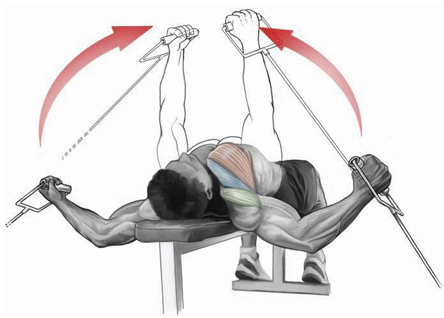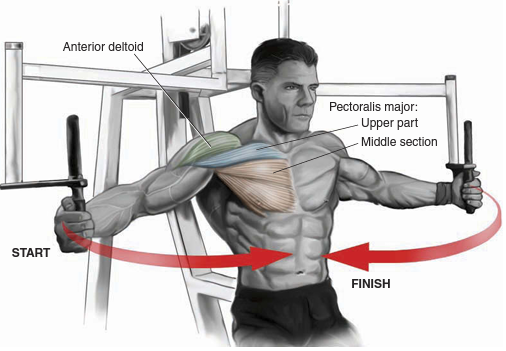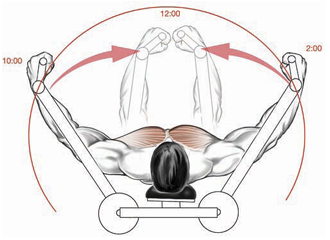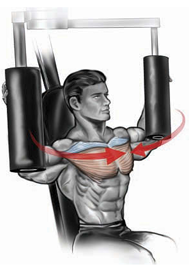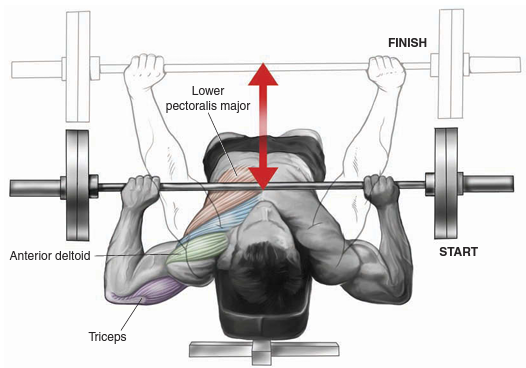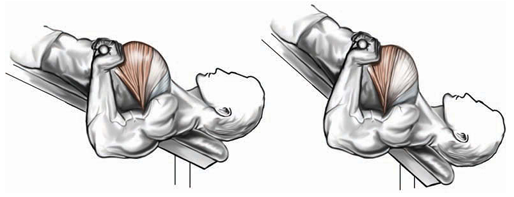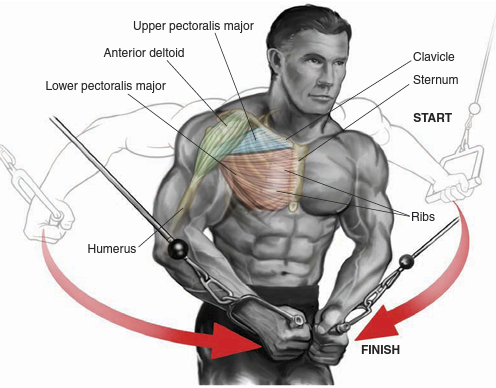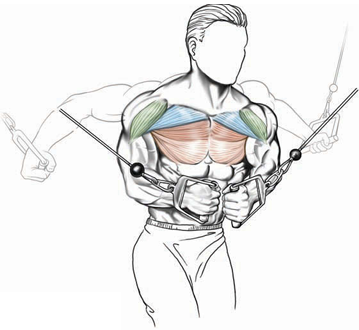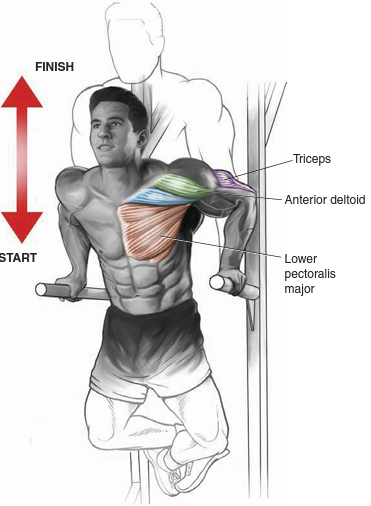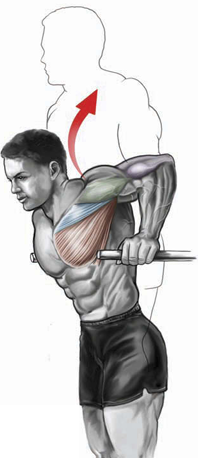Chest
Incline Barbell Press
Execution
1. While seated on an incline bench, take a shoulder-width overhand grip on the bar.
2. Lower the weight slowly until the bar touches your upper chest.
3. Push the bar straight up until your elbows lock out.
Muscles Involved
Primary: Upper pectoralis major.
Secondary: Anterior deltoid, triceps.
Anatomic Focus
Trajectory: The angle of incline determines trajectory. As the backrest is raised up and the incline increases, the focus shifts progressively higher up the pectoral muscle. The upper pectoral is best targeted when the backrest is inclined at 30 to 45 degrees to the fl oor. Steeper inclines of 60 degrees or more switch the focus to the anterior deltoid.
Hand spacing: A shoulder-width grip or slightly wider targets all areas of the upper pectoral muscle. Narrow hand spacing emphasizes the inner central portion of the chest and requires more effort from the triceps. Wider grips provide a greater stretch, targeting the outer portion of the muscle, and minimize triceps contribution; but as the hand spacing increases, so does the risk of injury.
Range of motion: To maximize pectoral work, fl are your elbows out wide as the barbell is lowered. A shorter rep terminating the press just before lockout keeps tension on the pectorals and reduces triceps assistance.
VARIATION
Machine incline press: This provides better stability and safety than the standard barbell press. Many machines offer a choice of grips. A neutral grip (thumbs up, palms facing together) emphasizes the pectorals better than a pronated grip (palms forward).
Incline Dumbbell Press
Execution
1. While seated on an incline bench, start with the dumbbells at chest level, palms facing forward.
2. Press dumbbells vertically upward until elbows lock out.
3. Lower dumbbells back down to your upper chest.
Muscles Involved
Primary: Upper pectoralis major.
Secondary: Anterior deltoid, triceps.
Anatomic Focus
Trajectory: The angle of incline determines trajectory. As the backrest is raised up and the incline increases, the focus shifts progressively higher up the pectoral muscle. The upper pectoral is best targeted when the backrest is inclined at 30 to 45 degrees to the fl oor. Steeper inclines of 60 degrees or more switch the focus to the anterior deltoid.
Grip: Dumbbell orientation affects hand position. Grasping the dumbbells with a pronated grip (palms facing forward) affords a greater stretch as the weight is lowered to the start position. A neutral grip (palms facing together) generates a better contraction at the lockout position.
Range of motion: To maximize pectoral work, fl are your elbows out wide as the dumbbells are lowered, and touch the dumbbells together at the top. A shorter rep terminating the press just before lockout keeps tension on the pectorals. The lower the dumbbells descend, the more the chest muscle stretches. Lowering the dumbbells too far can cause shoulder injury; it is safer to terminate the descent when the dumbbells reach chest level. Neutral grip at lockout
VARIATION
Variable-grip dumbbell press: Begin the exercise by holding the dumbbells with a pronated grip (palms forward), and rotate the dumbbells during the press so your palms face together (neutral grip) at lockout.
Incline Dumbbell Fly
Execution
1. While seated on an incline bench, begin with dumbbells directly above your chest, palms facing together.
2. Lower the dumbbells outward, bending elbows slightly as weight descends to chest level.
3. Raise dumbbells back up and together.
Muscles Involved
Primary: Upper pectoralis major.
Secondary: Anterior deltoid.
Anatomic Focus
Trajectory: The angle of incline determines trajectory. As the backrest is raised up and the incline increases, the focus shifts progressively higher up the pectoral muscle. The upper pectoral is best targeted when the backrest is inclined at 30 to 45 degrees to the floor.
Grip: Dumbbell orientation affects hand position. The fl y exercise works best when the dumbbells are held with a neutral grip (palms facing together), but a pronated grip (palms facing forward) can also be used as a variation.
Range of motion: The lower the dumbbells descend, the greater the pectoral stretch. Too much stretch can cause injury to the muscle and the shoulder joint. It’s safer to terminate the descent when the dumbbells reach chest level.
VARIATION
Machine fly: Performing the machine fl y (described here) with the seat low and the handles at eye level will target the upper pectorals.
Low-Pulley Cable Fly
Execution
1. In each hand, grasp a D-handle attached to the low pulleys, and stand upright.
2. Raise your hands up in a forward arc until the handles meet at head height.
3. Keeping your elbows stiff, lower the handles back to the start position.
Muscles Involved
Primary: Upper pectoralis major.
Secondary: Anterior deltoid.
Anatomic Focus
Trajectory: Standing forward so that the pulleys are slightly behind you affords a better trajectory to target the pectoral muscles.
VARIATION
Incline Cable Fly
Perform this exercise while lying on an incline exercise bench positioned centrally between the low pulleys, using similar technique to that of the incline dumbbell fly (described earlier).
Barbell Bench Press
Execution
1. Pectoralis major (middle section) Anterior deltoid Triceps While lying on a fl at bench, take a shoulder-width overhand grip on the bar.
2. Lower the weight slowly down to touch the middle chest.
3. Push the bar straight up until your elbows lock out.
Muscles Involved
Primary: Pectoralis major.
Secondary: Anterior deltoid, triceps.
Anatomic Focus
Body position: Your torso should lie fl at with your shoulders and buttocks in contact with the bench. Plant your feet fi rmly on the fl oor for stability. If your lower back is arched (or your buttocks rise off the bench), the focus shifts to the lower pectorals. Raising your feet off the fl oor by bending your knees may help target the middle chest, but stability and balance are compromised when your feet are not in contact with the fl oor.
Hand spacing: The ideal hand spacing is shoulder width or slightly wider. A narrow (close) grip emphasizes the inner pectorals and also targets the triceps. Wider grips target the outer section of the muscle and minimize triceps contribution.
Trajectory: The bar should move vertically up and down from the middle chest (nipple area). Flare your elbows out as the bar is lowered to maximize pectoral isolation.
Range of motion: A shorter rep terminating the press just before lockout keeps tension on the pectorals and reduces the amount of triceps assistance.
Grip: An underhand (supinated) grip on the bar switches the focus to the triceps.
VARIATIONS
Machine Chest Press
Machines provide better stability and safety than the standard barbell press. Many machines offer a choice of grips. A neutral grip (thumbs up, palms facing together) isolates the pectorals better than a pronated grip (palms forward).
Additional variation:
Close-grip bench press: Perform the exercise with hands spaced approximately 6 inches (15 cm) apart. The narrow grip targets the inner pecs and works the triceps.
Dumbbell Bench Press
Execution
1. While lying on a fl at bench, start with the dumbbells at chest level, palms facing forward.
2. Press dumbbells vertically upward until elbows lock out.
3. Lower dumbbells back down to middle chest. Muscles Involved Primary: Pectoralis major. Secondary: Anterior deltoid, triceps.
Anatomic Focus
Grip: Dumbbell orientation affects hand position. Holding the dumbbells with palms facing forward (pronated grip) provides more stretch as the weight is lowered to the start position. Holding the dumbbells with palms facing together (neutral grip) allows a better contraction in the lockout position.
Trajectory: Your torso should lie fl at on the bench, and the dumbbells should move vertically up and down from the middle chest (nipple area). To maximize pectoral isolation, fl are your elbows out wide during descent and touch the dumbbells together at lockout.
Range of motion: A shorter rep terminating the press just before lockout keeps tension on the pectorals and reduces triceps assistance. The lower the dumbbells descend, the more the chest muscle stretches. Lowering the dumbbells too far can cause shoulder injury; it is safer to terminate the descent when the dumbbells reach chest level.
VARIATION
Variable-grip dumbbell press: Hold the dumbbells with a pronated grip (palms forward) at the start; rotate the dumbbells as you press so that palms face together (neutral grip) at lockout.
Dumbbell Fly
Execution
1. While lying on a fl at bench, begin with dumbbells directly above middle chest, palms facing together.
2. Lower the dumbbells out wide, bending elbows slightly as weight descends to chest level.
3. Raise dumbbells together in an upward arc back to the vertical position.
Muscles Involved
Primary: Pectoralis major.
Secondary: Anterior deltoid.
Anatomic Focus
Grip: Dumbbell orientation affects hand position. The fl y exercise works best when the dumbbells are held with a neutral grip (palms facing together), but a pronated grip (palms facing forward) can also be used for variation. Range of motion: The lower the dumbbells descend, the greater the pectoral stretch, but also the greater the chance of injury. It’s safer to terminate the descent when the dumbbells reach chest level.
VARIATION
Cable Fly
Perform this exercise with the exercise bench positioned centrally between two cable machines, and use D-handles attached to the low pulleys.
Machine Fly
Execution
1. Grab the vertical handles, elbows slightly bent.
2. Squeeze the handles together until they touch in front of your chest.
3. Let your hands move back to the start position, keeping your elbows up.
Muscles Involved
Primary: Pectoralis major.
Secondary: Anterior deltoid.
Anatomic Focus
Grip: The fly exercise works best with a neutral grip (palms facing together), but a pronated grip (palms facing forward) can also be used for variation. Keep your elbows stiff and slightly bent throughout the movement.
Range of motion: The inner central portion of the pectoral muscle does most of the work as the handles are squeezed together. To emphasize the inner pecs, use a narrow range of motion focusing on the squeeze position. Perform partial reps, in which your hands move through a short 45-degree arc from the 12 o’clock (handles touching) position outward to 10 o’clock on the left and 2 o’clock on the right side. Keep your elbows straight to achieve maximum squeeze. The emphasis switches to the outer pecs when your hands move out wide. Do not allow the handles to pass behind the plane of your body, or you will enter the injury zone. It’s safer to terminate the stretch phase when your arms are in line with your chest.
Trajectory: Position the seat so the handles are level with your chest. To maximize pectoral isolation, keep your elbows high (shoulder level) during the movement.
Body position: When the seat is low and the handles are held high, the upper chest is emphasized. When the seat is high and the handles are held low, the lower chest is emphasized.
Resistance: Unlike dumbbell fl ys, where the resistance varies during the lift, the machine fl y affords a uniform resistance throughout the motion and is an excellent exercise for targeting the inner pecs.
VARIATIONS
Pec-Deck Fly
The pec-deck fly is a similar exercise using elbow pads instead of handles.
Additional variation:
One-arm machine fly: You can do this exercise using one arm at a time.
Decline Press
Execution
1. Lie on a decline bench and take a shoulder-width overhand grip on the bar.
2. Lower the weight slowly down to touch your lower chest.
3. Push the bar straight up until your elbows lock out.
Muscles Involved
Primary: Lower pectoralis major (sternal head).
Secondary: Triceps, anterior deltoid.
Anatomic Focus
Trajectory: The decline angle determines trajectory. As the bench is tilted head-down and the decline gets steeper, the focus shifts progressively lower down the pectoral muscle. The lower pectoral is best targeted at a decline of 20 to 40 degrees to the fl oor. Steeper declines shift the focus from the chest to the triceps. Flare your elbows out as the bar is lowered to maximize pectoral isolation.
Hand spacing: The ideal hand spacing is shoulder width. Wider grips target the outer section of the muscle, afford a greater stretch, and minimize triceps contribution. A narrow (close) grip targets the inner pectorals and requires more work from the triceps.
Range of motion: A shorter rep terminating the press just before lockout keeps tension on the pectorals and reduces the amount of triceps assistance.
VARIATIONS
Decline Dumbbell Press
Performing the decline press using two dumbbells affords an increased range of motion as the weight is lowered. A barbell stops when it touches the chest, whereas dumbbells can be lowered farther for additional stretch at the bottom of the lift.
Additional variation:
Machine decline press: Performing the decline press on a machine, such as the Smith machine, affords better stability and safety.
Decline Dumbbell Fly
Execution
1. While lying on a decline bench, begin with dumbbells directly above your chest, palms facing together.
2. Lower the dumbbells outward, bending elbows slightly as weight descends to chest level.
3. Raise dumbbells back up and together. Muscles Involved Primary: Lower pectoralis major (sternal head) Secondary: Anterior deltoid, triceps.
Anatomic Focus
Trajectory: The decline angle determines trajectory. As the bench is tilted head-down and the decline gets steeper, the focus shifts progressively lower down the pectoral muscle. The lower pectoral is best targeted at a decline of 20 to 40 degrees to the floor.
Grip: Dumbbell orientation affects hand position. The fl y exercise works best when the dumbbells are held with a neutral grip (palms facing together), but a pronated grip (palms facing forward) can also be used as a variation.
Range of motion: The lower the dumbbells descend, the greater the pectoral stretch, but also the greater the chance of injury. It’s safer to terminate the descent when the dumbbells reach chest level.
VARIATION
Variable-grip dumbbell fly: As the weight is lowered, hold the dumbbells with a pronated grip (palms forward) at the bottom, and then rotate the dumbbells during the lift so your palms face together (neutral grip) at the top.
Cable Crossover
Execution
1. Standing upright, grasp the D-handles attached to the high pulleys of a cable machine.
2. Squeeze the handles down together until your hands touch in front of your waist; keep elbows slightly bent.
3. Slowly return to the start position with your hands at shoulder level.
Muscles Involved
Primary: Lower pectoralis major (sternal head).
Secondary: Anterior deltoid, triceps.
Anatomic Focus
Trajectory: Your torso should be upright or tilted forward slightly at the waist. The level at which your hands meet determines the focus on the muscle. A low trajectory, in which the handles meet in front of your hips or waist, targets the lowest fi bers of the pectoral muscle. A high trajectory, in which the handles meet at chest level, targets the midsection of the pecs.
Range of motion: Crossing over your hands at the bottom increases the range of motion and targets the inner, central portion of the pectorals. Extending the start position by allowing your hands to pass above shoulder or head height affords a greater stretch but also places unnecessary stress on the shoulder joint.
VARIATION
Seated crossover: Newer machines allow you to perform this exercise while seated with a back support.
Chest Dip
Execution
1. Grab the parallel bars, supporting your body with elbows locked straight.
2. Bend your elbows, lowering your torso until upper arms are parallel to the f l oor.
3. Push yourself back up until your elbows lock out.
Muscles Involved
Primary: Lower pectoralis major (sternal head).
Secondary: Triceps, anterior deltoid.
Anatomic Focus
Trajectory: The position of your torso affects the focus of the exercise. A slight forward tilt is better for targeting the pectorals, and the more you bend forward the harder you work the pectorals. An upright posture shifts the focus to the triceps, and the more you straighten your torso the more you involve the triceps. Flare your elbows out as you descend to maximize pectoral isolation.
Grip: A standard grip on the parallel bars with thumbs pointing forward works best when targeting the chest. A reverse grip with thumbs pointing backward shifts the focus to the triceps.
VARIATION
Machine dip: You can perform this exercise while seated on a machine. But since most dip machines restrict torso motion, they tend to target the triceps more than the chest.
From book: Bodybuilding anatomy, Nick Evans, 2007
Related Posts
-
 TIРЅ FOR HЕАLTHY EАTING
1 Comment | Oct 20, 2015
TIРЅ FOR HЕАLTHY EАTING
1 Comment | Oct 20, 2015 -
 Arms
No Comments | Dec 29, 2014
Arms
No Comments | Dec 29, 2014 -
 Back
No Comments | Jan 8, 2015
Back
No Comments | Jan 8, 2015 -
 Abdominals
No Comments | Jan 13, 2015
Abdominals
No Comments | Jan 13, 2015

